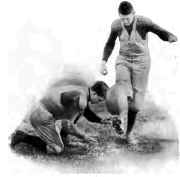Place Kick
Description
This section is from the book "Football For Player And Spectator", by Fielding H. Yost. Also available from Amazon: Football for Player and Spectator.
Place Kick
The place kick is made by placing the ball in position on the ground and kicking it from this location. The value of a good place kicker to the team cannot be estimated for, by his work, the game may be won or lost. Place kicking has almost entirely taken the place of drop kicking, because it is more accurate. It is used to convert touchdowns into goals, to kick goals from the field, to kick off, and is often used to kick out after a touchback, instead of punting.
There are two illustrations used in connection with this article to show the form and style necessary in order to become a proficient and accurate place kicker. The skillful execution of a place kick depends almost as much upon the holder of the ball as upon the kicker himself. Great care should be used by the former in placing the ball upon the ground in the exact position desired by the kicker. The holder of the ball must not change its position in the least in removing his hands or fingers from under it. He must not remove his top hand but must permit the kicker to kick the ball while the upper hand is yet in place. The holder of the ball must be steady and cool.

Figure Three. - The position of leg, foot and body just after ball has left the foot. The kick should be followed out.
In making the place kick, the kicker's position should be about four feet behind the ball. He should draw an imaginary line directly through the center of the goal bar, through the center of the ball, and the kicking leg should be in a direct line with the center of the ball and the center of the goal bar. In other words, a straight line, drawn from the right or kicking toe through the center of the ball, should pass directly across the center of the goal bar.
The kicker's position on short kicks should be not over four feet behind the ball. If he stands too far away it is harder for him to approach and kick exactly as he should, and he acquires no advantage by being so far back. After the kicker has assumed his proper position and the ball is ready, he should step forward about six inches with his right foot and then step forward with the left foot until the toe is practically on line with the rear of the ball, but a little to the left: The right toe should then come forward, toe turned down, the kicker's eye in the meanwhile glued to the spot on the ball which he wishes the toe to hit. The right foot should be brought forward along the original line. The kick is made more by the swing of the knee than of the hip. Follow the kick through after the ball has been struck as in Position 2. The feet should travel along the line which the ball is to take. Do not finish as in a punt, but follow the kick through.
When distance is wished, as in an attempt for a goal from the field at the 40-yard line, the distance of the kicker behind the ball should be increased and more of the swing of the leg from the hip should be put into the kick, to add force and distance. The same observations in the "line of kick" should be followed when a kick is to be made from any position on the field, whether from near the center or near the sidelines. The holder of the ball and the kicker should work together enough to become thoroughly in touch with each other. Some kickers require that the ball should be almost vertical in its position on the ground;

Position to assume just before ball is touched to the ground. Care must be taken to place ball on ground in same position as held. Kicker stands close for short kick.
others that the top he tilted back toward the kicker. What is best suited to the individual kicker can be learned only by constant practice.
In kicking goals from touchdowns there is no necessity for hurry. Take plenty of time, observing carefully the condition of wind and weather. There is much difference in kicking a dry, new ball, and a wet, heavy one, that has been used perhaps throughout the greater part of a game. More care is necessary when the kick is against the wind, than when with it.

As the ball is kicked from the ground the kicker should have his toe turned down and the eyes on the spot he wishes his toe to hit. Follow kick through toward center of goal bar.
Summed up, the important points in a place kick are to see that the ball is placed correctly on the ground; that the kicker observe the ball closely in making his kick, instead of directing his attention to the goal bar; that he kicks the ball with the toe turned down, and that the kick is made on the straight line to the center of the goal bar.
Continue to:


